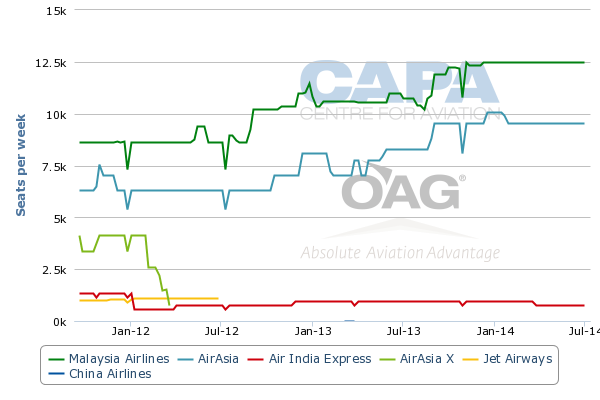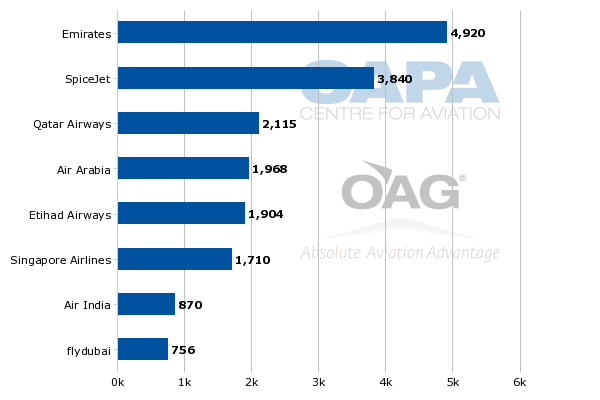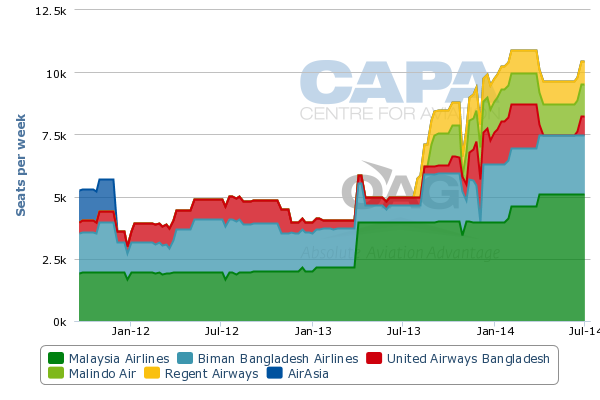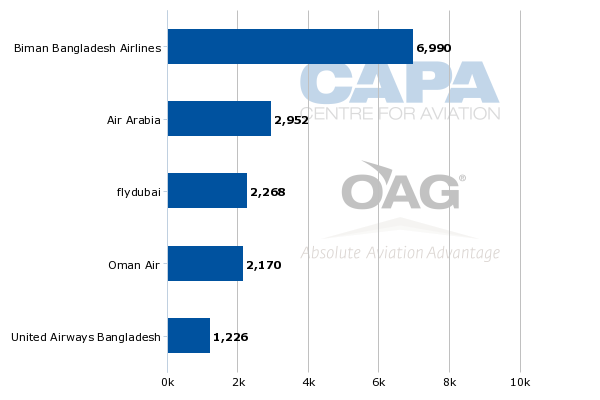Malindo Air launches India, further shaking up Kuala Lumpur market for Malaysia Airlines and AirAsia
Malaysia's Malindo Air is moving forward on its delayed expansion plans for India with four new routes which will quickly give the Lion Air Group affiliate a 15% share of the Malaysia-India market. Malindo is seeking to become a major player in the Malaysia-India market as well as offer connections in the fast growing Indonesia-India market.
Malindo is targeting the Kuala Lumpur-Delhi and Kuala Lumpur-Mumbai routes, which currently are only served by Malaysia Airlines (MAS). It will compete against AirAsia to Tiruchirappalli and will become the only carrier linking Kuala Lumpur with Ahmedabad.
The hybrid carrier is also adding a second destination in Bangladesh, Chittagong, as part of its push into South Asia. By its first anniversary in late Mar-2014, Malindo will account for 12% of total capacity between Malaysia and South Asia.
Malindo finally launches India, ending six-month delay
Malindo launched domestic services in late Mar-2013 and was initially planning to make India its first international destination with flights starting in Jun-2013. But Malindo had to postpone several times the launch of India services as it waited to secure the required approvals from Indian authorities.
See related report: Lion's Malindo breaks AirAsia-MAS duopoly in Malaysian domestic market. Next stop: Delhi
The carrier shifted gears in mid-2013 and decided to make Bangladesh its first international destination, with one daily flight on the Kuala Lumpur-Dhaka route launching at the end of Aug-2013. Two other international routes, daily services from Kuala Lumpur to Jakarta and Bali in Indonesia, were launched in late Sep-2013.
The approval process for new services to India is poorly defined as a result of which airlines face considerable uncertainty with respect to scheduling a start date. Malindo's application to launch four planned India routes frustratingly dragged on for several months until finally it cleared in early Dec-2013. A daily service to the Indian capital Delhi was launched on 30-Dec-2013 followed by a daily service to Tiruchirappalli in southern India on 2-Jan-2014.
Malindo has set a 15-Feb-2014 launch date for its third India route, Kuala Lumpur-Mumbai, which will initially operate five times per week. The carrier's fourth Indian route, Kuala Lumpur-Ahmedabad, is now slated to be served four times per week from 19-Mar-2014. All of the carrier's India routes will be operated with 180-seat 737-900ERs in two-class configuration. Malindo currently operates six 737-900ERs along with four ATR 72-600 turboprops.
Malindo to capture 15% of Malaysia-India market at the expense of MAS and AirAsia
The 23 weekly flights to India that Malindo plans to operate by the end of Mar-2014 will give the carrier 4,140 one-way seats in the Malaysia-India market. This equates to about a 15% share of total capacity in the Malaysia-India market.
Once all the Malindo flights are added, MAS will see its share of capacity in the Malaysia-India market drop by about 7ppts, from 53% in late Dec-2013 to 46% in late Mar-2014. AirAsia's share will drop by about 8ppts from 43% to 35%.
Malaysia-India capacity share (% of seats) by carrier: Mar-2014
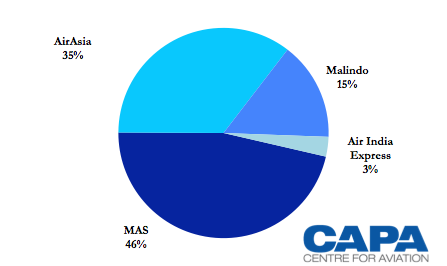
MAS currently operates 66 weekly flights to six Indian destinations while AirAsia has 56 weekly flights to five Indian destinations, according to OAG data. All of AirAsia's India flights are operated with A320s in 180-seat single-class configuration as A330 operator AirAsia X no longer serves India while 14 of MAS' 66 flights are operated with widebodies and 42 with 737-800s in two-class configuration with 160 or 166 seats.
Over the past two years MAS has increased capacity to Malaysia by about 45%, according to CAPA and OAG data. MAS is keen to add more flights to India as part of its new business plan, which focuses on thickening its schedule within Asia-Pacific to maximise connections. But MAS has said it is currently unable to pursue further expansion in India due to bilateral restrictions.
The Malaysia-India air services agreement caps capacity to the six main Indian cities of Delhi, Mumbai, Bangalore, Chennai, Hyderabad and Kolkata. MAS serves all six of these cities except Kolkata. It added its first secondary Indian city, Kochi, in Sep-2013 and could potentially launch more secondary destinations but has more interest in increasing capacity to its existing destinations.
AirAsia also has increased capacity to India by about 50% since the beginning of 2012. But the approximately 3,200 weekly one-way seats it has added only partially offsets the approximately 4,100 weekly one-way seats sister carrier AirAsia X offered before pulling out of the Malaysia-India market in early 2012.
Approximately one million origin-destination (O-D) passengers travel between India and Malaysia per annum on non-stop services. Despite accounting for more than half the seat capacity on the route, MAS' share of O-D traffic is estimated to be around 25-30% as more than 50% of the passengers it carries on its Indian services connect at Kuala Lumpur to/from other points in Asia, Australasia and North America. AirAsia, with its focus on point-to-point passengers (traffic connecting beyond Kuala Lumpur to other ASEAN points only accounts for an estimated 6-8% of Indian carriage) has a share of close to 55% of O-D traffic.
Malaysia to India capacity by carrier excluding Malindo (one-way seats per week): 19-Sep-2011 to 6-Jul-2014
AirAsia is potentially interested in adding flights from Kuala Lumpur to India to better leverage network synergies with planned start-up AirAsia India. But as in the case with MAS, bilateral restrictions limit expansion opportunities to secondary cities. For example, more flights from Kuala Lumpur to Bangalore, Chennai or Kolkata - all of which are reported to be potential bases for AirAsia India - cannot be mounted without a new agreement. Alternatively, as and when the 5 year/20 aircraft qualification threshold is lifted for Indian start-up carriers seeking to operate international services, AirAsia India could launch services to Southeast Asia utilising Indian entitlements.
AirAsia would be able to add more capacity to Tiruchirappalli or Kochi and add other secondary destinations in southern India (central, northern or western India are not within the four-hour envelope from Kuala Lumpur that AirAsia sticks to). But opportunities to work with AirAsia India at such destinations would be limited. AirAsia X is also unable to re-enter the Delhi and Mumbai markets unless the bilateral is expanded.
Malindo seeks to add more Indian destinations after the initial four
Malindo essentially received the last available Malaysian allotments at the six main cities, taking over the rights which were previously used by AirAsia X for Delhi and Mumbai. With limited interest on the part of Indian carriers to operate to Kuala Lumpur, and that too primarily from Chennai only, the prospects for further expansion of the bilateral agreement may be limited, and any small incremental growth in seat entitlements would need to be split between three Malaysian carriers.
Malindo has said it is looking at adding more destinations in India later in 2014 as it takes delivery of up to eight additional 737-900ERs. Amristar, Chennai, Kochi, Madurai and Pune have been cited as potential destinations. Of these cities only Chennai is capped by the bilateral.
Malindo initially applied to serve Kochi, which was originally slated to be launched at the end of Jun-2013 along with Delhi. But the carrier subsequently switched gears and instead decided on Ahmedabad, which was not on its initial list of India routes.
As Malindo waited on Indian approvals, the Kuala Lumpur-Kochi route became more competitive with MAS announcing plans in early Jul-2013 to serve Kochi. MAS began daily 737-800 service to Kochi at the beginning of Sep-2013, giving it six destinations in India along with Bangalore, Chennai, Delhi, Hyderabad and Mumbai.
Malindo is wisely staying away from Kochi during its initial India expansion phase as it is a relatively small market that is also served from Kuala Lumpur by AirAsia with 10 weekly flights. All of Malindo's India routes have at most one direct competitor - MAS to Delhi and Mumbai and AirAsia to Tiruchirappalli. Ahmedabad is not currently served non-stop by any carrier from Kuala Lumpur.
Malindo breaks the MAS monopoly on the Delhi and Mumbai routes
MAS enjoyed a monopoly on the Kuala Lumpur-Delhi and Mumbai routes since AirAsia X dropped both in early 2012. MAS currently serves Delhi with two daily flights, one using 737-800s and one using 777s, and Mumbai with 12 weekly flights, seven using 777s and five using 737-800s. MAS has increased capacity to Mumbai by about 40% since the AirAsia X pull-out but capacity has remained flat to Delhi.
Mumbai and Delhi are not the largest Indian markets from Malaysia. Chennai is larger as it is in the region of India where a big portion of Malaysia's Indian population have their roots. AirAsia and MAS both operate two daily flights to Chennai. The only service to Malaysia by an Indian carrier is also from Chennai - a four times per week service from Air India Express. (Jet Airways served the Chennai-Kuala Lumpur route for several years until 2012, when it pulled out citing low yields.)
While Chennai potentially has the demand to support more capacity from Kuala Lumpur, yields are generally low as it is primarily a leisure or visiting friends and relatives (VFR) market and has a fair amount of competition. The Delhi and Mumbai markets have more business traffic and significantly less competition. Malindo's two-class full service product is well positioned to compete for business traffic. Malindo offers complimentary meals, drinks, in-flight entertainment with seatback monitors and check-in luggage in both cabins.
Malindo also works closely with travel agents, which should help the carrier with sales in India. Local distribution was the main challenge for AirAsia X on its Indian routes as most Indians use travel agents or online travel agents for international flight bookings.
Delhi and Mumbai to Kuala Lumpur do have potential as business and leisure routes however with services to date largely restricted to full service operations the market has not been stimulated except for the brief attempt by AirAsia X, which had a weak distribution strategy. Kuala Lumpur is not yet perceived in the Indian market as attractive a destination as Bangkok or Singapore, however with more aggressive marketing of Malaysia and competitive pricing growth is possible.
Malindo is offering all inclusive one-way fares to Delhi and Mumbai starting at less than MYR600 (USD183) for economy and less than MRY1,000 (USD305) for business. With the right local distribution strategy it should be able to stimulate leisure demand and also attract some business traffic, particularly smaller companies and entrepreneurs.
Malindo to take on AirAsia in Tiruchirappalli market, an interesting battle
Kuala Lumpur-Tiruchirappalli is more of a VFR and leisure market with most demand coming from the Malaysia end. AirAsia has been very successful on the route, its largest to India with three daily flights. The second frequency was added in Oct-2012 and the third frequency less than one year later, in Sep-2013. The decision to add the third flight was likely a competitive response to Malindo's planned entry.
Malindo will look to stimulate demand with a competitive fare while offering a full-service product. Malindo is offering all-inclusive one-way fares to Tiruchirappalli starting at about MYR300 (USD92). AirAsia fares start at about MYR200 (USD61) but when including bags and meals are about the same as Malindo. As a price-sensitive leisure and VFR route it remains to be seen how the market responds to a full service alternative to AirAsia. To strengthen its visibility on the route Malindo may need to consider an increase in frequency at the risk of excess capacity.
Malindo is only the fourth foreign carrier serving Tiruchirappalli, joining AirAsia, Tigerair and SriLankan Airlines. Air India Express also operates international services from Tiruchirappalli to Dubai and Singapore.
Tiruchirappalli international capacity (seats) by carrier: 30-Dec-2013 to 5-Jan-2014
Malindo to test out unproven market in Ahmedabad
Malindo is taking a bit of a gamble with Ahmedabad as it is an unproven market. Ahmedabad is only served by one carrier from Southeast Asia, Singapore Airlines (SIA). Despite the potential of Ahmedabad as the commercial centre of one of India's most industrialised and fastest growing states with a large global diaspora, the international market from the city has under-performed and Asian carriers in particular have been disappointed.
The other six foreign carriers currently serving Ahmedabad are all from the Middle East, who have fared better as they can provide connectivity to/from the key VFR markets in the UK and North America. Indeed Emirates announced earlier this week that it will be introducing a three-class configured aircraft on the Dubai-Ahmedabad route from Aug-2014. Air India and SpiceJet also operate international services at Ahmedabad but only to the Middle East.
Malindo will need to offer highly competitive pricing on Ahmedabad and it may take longer than planned to achieve route profitability.
Ahmedabad international capacity (seats) by carrier: 30-Dec-2013 to 5-Jan-2014
Thai Airways' regional unit Thai Smile launched services to Ahmedabad at the end of Mar-2013 but dropped the route after only seven months - not an encouraging sign for the prospects of a similar route from Kuala Lumpur. Malindo has already pushed back the launch of Ahmedabad from the end of Jan-2014 to 19-Mar-2014.
The carrier is trying to stimulate demand by offering one-way fares which start at MYR640 (USD195). But the local Ahmedabad-Kuala Lumpur market is relatively small and Malindo at least for now does not have nearly the network that SIA can offer beyond Singapore.
Malindo however is relying heavily on transit traffic to support its new India flights. The carrier is already selling connections from all four of its initial destinations in India to several domestic destinations in Malaysia as well as Bali and Jakarta. AirAsia has not generated significant volumes of transfer traffic, estimated at 6-8% of its total carriage on Indian routes, and Malindo will need to commit resources to promoting beyond destination and work to identify specific agents that can assist in this regard.
Malindo seeks to generate significant transit traffic
Flights from Kuala Lumpur International Airport (KLIA) to Penang and Johor Bahru in western Malaysia were added in recent months with timings that are designed to connect with Malindo's South Asia flights, which with the exception of Tiruchirappalli operate during overnight hours. Quick connections are also available at KLIA to the main eastern Malaysia cities of Kota Kinabalu and Kuching, which were Malindo's initial two routes when the carrier commenced operations in late Mar-2013.
Malindo initially only served Penang and Johor Bahru from Kuala Lumpur closer-in airport Subang, which would have required passengers from these key destinations to take a bus or taxi across Kuala Lumpur when making international connections. The MAS group already served Penang and Johor Bahru from both Subang and KLIA while AirAsia only serves KLIA. (Subang is only currently open to turboprop flights.)
Malindo is also confident it can generate a large volume of transit traffic between Indonesia and India. Indonesia is the largest international market from India which is currently not served with any non-stop flights. Malindo can leverage Lion, which has a strong brand and network of travel agents in Indonesia, to sell in Indonesia flights to India via Kuala Lumpur. Malindo also plans to rely on Indian agents to sell beyond Kuala Lumpur to Bali, an Indonesian resort destination that is popular with Indians.
Malindo will be competing mainly against MAS and SIA in offering one-stop connections from India to Jakarta and Bali. AirAsia, which sells a Fly-Through transit product, also offers connections from India to Indonesia via Kuala Lumpur but of the five destinations in its Indian network only Tiruchirappalli is also served by Malindo.
Malindo to consider tie-up with Indian airline
Malindo is also expected to offer at a later stage domestic connections on the Indian end. Malindo would need to secure an Indian carrier as a partner to make such connections a reality. But Malindo's hybrid model, which already includes interlining with its sister carriers in the Lion Air Group, and its interline-friendly reservation system would make it relatively easy to start working with carriers outside the group.
There should be interest from some Indian LCCs which are independent and not affiliated with a group. Go Air, IndiGo and SpiceJet would all fall under this category while AirAsia India, Air India Express and Jet Lite are affiliates or subsidiaries of groups. However the incremental revenue potential would have to signficantly outweigh the additional complexity and costs that are added as a result of partnering with another carrier.
SpiceJet started interlining in Jan-2014 with Tigerair. SpiceJet could easily extend this model, which involves SpiceJet operating domestic connections to some of Tigerair's India-Singapore flights, to include other Southeast Asian LCCs or hybrid carriers such as Malindo. Although it is as yet unclear whether the Tigerair and SpiceJet partnership will deliver significant volumes to either carrier but particularly to SpiceJet.
See related report: Tigerair and SpiceJet partnership leads accelerated LCC growth between India and Southeast Asia
The SpiceJet-Tigerair relationship is not exclusive and does not involve an equity stake. SpiceJet has been looking at selling a minority stake to a foreign airline or airline group. Malindo and Lion could offer intriguing synergies. SpiceJet has only one destination in Southeast Asia, Bangkok, and also is a 737-900ER operator.
A partnership or even equity investment in India would be logical for Malindo as South Asia has emerged as a strategically important region for the new carrier. Such a move would also counterbalance AirAsia's India franchise. But due to the strectched financial position of several Indian carriers, opportunities in incumbent airlines may be less attractive. However, the expected lifting of the 5 year/20 aircraft rule (which limits new airlines in India to the domestic market until they are at least five years old and operate at least 20 aircraft) could open up significant opportunities for a greenfield venture.
Malindo expands Bangladesh operation with Chittagong
In addition to the four planned routes to India, Malindo plans to launch three weekly flights to Chittagong in Bangladesh on 16-Jan-2014. The addition of Chittagong will give Malindo a total of 10 weekly flights and 1,800 one-way seats to Bangladesh as it already operates a daily flight to Dhaka. Malindo will account for about a 17% share of seat capacity between Malaysia and Bangladesh after the Chittagong service is launched.
Malaysia-Bangladesh capacity share (% of seats) by carrier: late Jan-2014

Malaysia-Bangladesh is a large migrant worker market that is currently served by five carriers. MAS is the largest carrier in the market with two daily 777 flights giving it a 37% share of capacity in the market. Biman also has two daily frequencies, using a combination of 777s and smaller A310s, giving the Bangladeshi flag carrier a 22% share of capacity. Smaller Bangladeshi carrier United Airways operates between one and two daily frequencies using MD-80s while and another small Bangladeshi carrier, Regent Airways, operates one daily flight with 737-800s.
MAS plans to add over the next few months a third frequency to Dhaka, which will slightly reduce Malindo's share. The third frequency will operate four days per week with 737-800s from the end of Feb-2014 and be upgraded to daily, also with 737-800s, from the beginning of Apr-2014, according to OAG data. MAS only added its second frequency to Dhaka in Apr-2013, an indication of the strong growth in the Malaysia-Bangladesh market.
Since the beginning of 2012 total capacity between Kuala Lumpur and Dhaka has more than doubled. Kuala Lumpur is now the largest international destination from Dhaka with about 20,000 weekly return seats.
Kuala Lumpur to Dhaka total seat capacity (one-way seats per week): 19-Sep-2011 to 6-Jul-2014
AirAsia should re-consider Dhaka (and Delhi and Mumbai)
Noticeably absent in the market is AirAsia, which dropped service to Dhaka in 2011. AirAsia originally took over the route in 2009 from AirAsia X, which briefly served Dhaka. AirAsia should look to re-enter the market as Dhaka is now the largest Asia-Pacific destination from Kuala Lumpur that is not served by either A320 operator AirAsia Berhad or A330 operator AirAsia X.
Dhaka is Kuala Lumpur's 14th largest international route within the Asia-Pacific region based on current seat capacity. There are no other routes among the top 30 that are not already served by AirAsia or AirAsia X. The only other Kuala Lumpur-Asia Pacific routes in the top 40 not currently served by AirAsia or AirAsia X are Delhi and Mumbai. AirAsia X would likely be keen to re-enter these two markets, particularly in light of the upcoming launch of AirAsia India, but cannot unless there is a breakthrough in the Malaysia-India bilateral.
As Kuala Lumpur-Dhaka is just under four hours, AirAsia Berhad has the first right to serve the route over AirAsia X as per the arrangement between the two companies. AirAsia X would be the operator on Kuala Lumpur-Mumbai and Kuala Lumpur-Delhi as the former is about five hours and the latter about five and a half hours. (Malindo has a different approach to medium-haul flights as it uses a narrowbody aircraft with more range and a less dense configuration.)
Malindo pounces on opportunities in South Asia market
Malindo was smart to recognise the opportunity in the Malaysia-Bangladesh market. The two countries have a liberal air services agreement and Bangladeshi authorities were very welcoming to Malindo, quickly approving its initial application to serve Dhaka while Malindo's applications to Indian authorities dragged on for several months.
Bangladesh has also been very receptive in having Malindo serve Chittagong. Malindo will be only the fourth foreign carrier operating passenger services to Chittagong and the first that is not from the Middle East, according to OAG data. Biman and United Airways also operate international services from Chittagong but only to the Middle East and India.
Chittagong international capacity (seats) by carrier: 30-Dec-2013 to 5-Jan-2014
Malindo also has been smart in identifying under-served routes in India, pouncing on the available traffic rights to Delhi and Mumbai. Malindo is also keen to test out new Malaysia-India routes that are not restricted by the bilateral, starting with Kuala Lumpur-Ahmedabad. If Ahmedabad proves to be successful, Malindo will likely move forward in expanding its network of secondary Indian cities as it is unlikely to gain access to other major cities given the current bilateral restrictions.
South Asian routes are important additions for Malindo. North Asia will be next
The South Asian routes also help Malindo reduce its cost base as almost all of them are operating during overnight hours, leading to higher average utilisation on the carrier's six 737-900ERs. As Malindo takes up to eight more 737s in 2014 it will look to add more flights to South Asia to balance out its operation, which involves using the 737s during the day to operate domestically and to Indonesia. However, yields will be a challenge for Malindo on South Asian routes as the market is extremely price sensitive. While passenger growth targets may be met through market stimulation, achieving route viability may take longer than planned.
Malindo also plans to add flights to North Asia by the end of 2014. These will likely include overnight flights to greater China from Kuala Lumpur as well as shorter daytime flights to greater China from Kota Kinabalu.
As CAPA reported in Aug-2013, the Lion Group is keen to use Malindo to expand its presence in the international market with hubs at Kuala Lumpur and Kota Kinabalu. The anticipated second hub at Kota Kinabalu, which is better geographically positioned than Kuala Lumpur for connections between Indonesia and North Asia, will likely see international flights to Indonesia and North Asia along with new turboprop domestic flights to destinations within east Malaysia.
See related report: Malindo emerges as Lion Group's main international carrier with nine new routes from Kuala Lumpur
Malindo has been looking at opening a turboprop base at Kota Kinabalu as it adds up to seven ATR 72s in 2014. Malindo currently only serves Kota Kinabalu from Kuala Lumpur and Johor Bahru - both routes using 737-900ERs which are based at Kuala Lumpur.
Malindo to serve at least nine international routes by one-year anniversary
The four new India routes, Chittagong and the upcoming launch of service to Batam in Indonesia from Subang will give Malindo at least nine international routes by the end of Mar-2014, when the carrier celebrates its one-year anniversary. Of these nine routes, only three are served by AirAsia while six are served by the MAS group.
Malindo also currently operates 13 domestic routes, including six from KLIA, six from Subang and Johor Bahru-Kota Kinabalu. Most of the carrier's expansion in 2014 will come in the international market, with South Asia being the focus area for 1Q2014.
Malindo will have its share of challenges in 2014 as it aims to carry about 2 million passengers, compared to 900,000 in 2013, in Malaysia's intensely competitive market. But the carrier's cost base will come down as it expands its fleet and improves utilisation rates with more overnight flying.
Malindo should also benefit significantly from a reduced reliance on Malaysia's domestic market, which accounted for about 85% of the carrier's seat capacity prior to the recent launch of services to India. It is too early to call Malindo's network and product strategy successful but it is innovative and has certainly captured the attention of the carrier's two main competitors - as much as they do not want to admit it.
